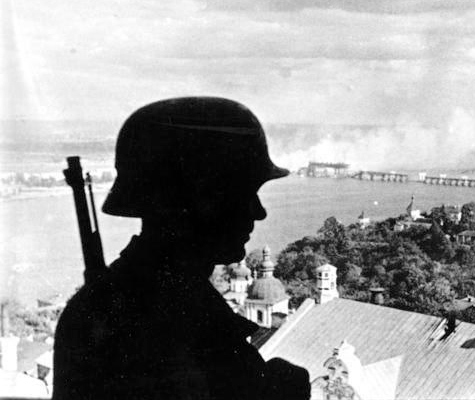
For the first time, the main hero of Victory Day is not Russia, but Ukraine. The attention of countries that truly honor this May holiday will be drawn to Ukrainians. A nation that once suffered grief because of the invasion of a hateful regime now suffers from it again. The slogan “never again” has been used to commemorate WWII victims on Victory Day, but now it is clear that “never” was an illusion, and “again” has repeated.
Russia turned WWII into a central myth. It attacks someone else’s historical memory, someone else’s identity, someone else’s borders. It forbade Ukraine from having its own view of history and labeled any resistance to its imperialism as “Nazism.” Moreover, the Russians try to downplay the contributions of other nations to the defeat of the Nazis.
What do these lies look like? Let’s analyze it point by point.
When did Russia first begin to privatize WWII?
In 2005, after the Orange Revolution, Russia began using the memory of World War II as an instrument of its aggression. Putin deemed Viktor Yushchenko’s win as influenced by the West. The Kremlin perceived this as a humiliation and decided to prepare for a rematch. Moscow began to look for a narrative that could contain Ukraine’s pro-European aspirations, especially one that would remind the West who it has to thank for the defeat of Nazism.
An old myth about the “Great Patriotic War” was pulled out of the box where the Soviet legacy lay. On the eve of the pompous celebration of the 60th anniversary of the victory, Russian political strategists came up with a large-scale PR campaign called “St. George’s ribbon”.
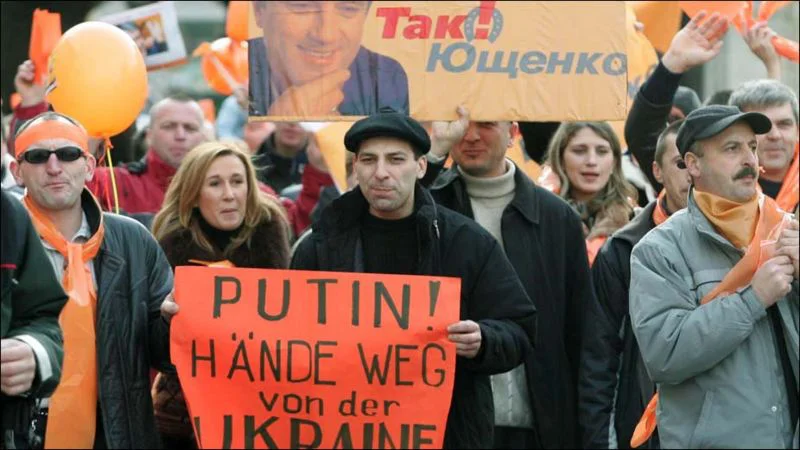
In November 2004, a wave of protests against Moscow's interference in the Ukrainian elections swept across Europe with the slogan "Putin, get your hands off Ukraine". The photo shows a rally in Vienna, 28 November 2004. Photo: Wikipedia
A few years later, Russian propaganda went on the offensive. Rebellious Ukraine continued its movement to join NATO and the EU, so they chose to “exclude” Ukrainians from the list of winners and inflate their contribution to the destruction of Nazism.
On December 16, 2010, during a call with the president of the Russian Federation, Aleksandr Zaldostanov, Putin’s devoted associate and champion of the “we can do it again” idea, asked his boss a pre-prepared question. So began the Kremlin’s special information operation. Its goal was to show that Russia could have beaten Nazi Germany without the help of the Ukrainians.
Putin then went on a tirade: “If we look at the statistics of the Second World War, it turns out that the Russian SFSR suffered the greatest losses in the Great Patriotic War, which is more than 70%. I don’t want to offend anyone, but this means that the war was won mainly at the expense of the human and industrial resources of the Russian Federation. This is a historical fact.” Putin also added: “We would have won anyway because we are a country of winners.”
At the time, of course, no one could have guessed what future “victories” this country of winners could carry out in Bucha and Mariupol.
How does Russia measure its victory?
The calculation of losses in World War II is politicized in Russia. Firstly, the chronological framework is limited to the period of the German-Soviet war in 1941–1945. However, the time when the Soviet Union helped Nazi Germany, from 1939 to 1941, is not discussed.
Second, Russia follows the model of totalitarian societies, where the state is in charge of both a person’s life and death. The monopoly did belong to the party. It was the prerogative of the general secretaries of the Communist Party of the Soviet Union to make public the losses of the Soviet Union in the “Great Patriotic War.” The professional environment had to obey with and perpetuate the already announced data and theses.
For half a century, from 1946 to 1990, the estimate of Soviet losses changed four times!
The first figure — 7 million dead — was announced by Stalin. The second — 20 million — was put into “academic” circulation by Khrushchev in 1961. The third — “more than 20 million” — was voiced by Brezhnev in his speech on the occasion of the 20th anniversary of the victory in 1965. The final current number of losses — 27 million — comes from Gorbachev.
The problem with the calculations was not only the overall estimate of the number of dead but also the ratio between military and civilian losses. The predominance of civilian casualties over losses of soldiers is a terrible feature of WWII.
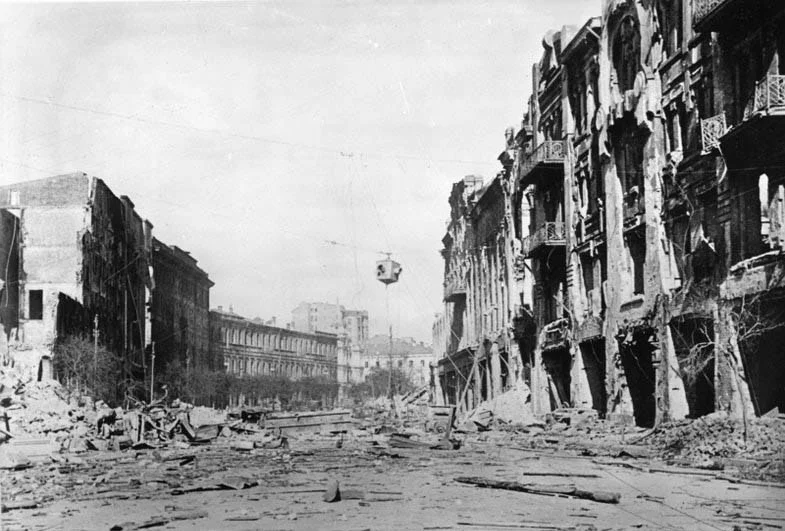
Khreshchatyk Street in Kyiv in ruins, September 1941. The Bolsheviks used the tactic of "scorched earth" in the centre of Kyiv before the Nazi offensive. Photo: Wikipedia
Where did the 27 million victims come from?
In the early 1990s, experts were able to work freely with data. Academics still use the calculations made by a group of Russian military experts who were headed by Colonel-General Grigoriy Krivosheev to figure out how many people died.
According to these calculations, the total number of losses suffered by the USSR in the German-Soviet War of 1941–1945 was 26.6 million people. 8.668 million soldiers died on the front lines. In particular, there were 5.756 million Russians and 1.377 million Ukrainians among them: 66.4% and 15.9% of the total number of USSR military losses, respectively. If you add to the Russian martyrology those who died among ethnic groups living in the territory of Russia (Karelians, Kalmyks, Buryats, Komi, etc.), then there will be 70% of those whom Putin calls.
The fundamental deceit is hidden in the details – it all depends on how to count.
For instance, Krivosheev’s calculations show that the statistics on ethnicity or territory are disputed. For Krivosheev, a representative of the Soviet school, the correlation between nationality and territory was something secondary. It represented the Soviet people in general, a significant portion of which consisted of Russians as a “state-forming nation”. But were all Russians citizens of the RSFSR and conscripts from it’s territory?
Let’s take Soviet Kazakhstan as an example. According to the 1939 census, the total population of the Kazakh Soviet Socialist Republic was 6,151,000. In particular, 2,459,000 were ethnic Russians and 2,328,000 were ethnic Kazakhs. Kazakhstan was the only Soviet republic in which the titular nationality was a minority. This demography was the result of the famine of 1932–1933, which claimed the lives of one and a half million indigenous people.
So, how are the ethnic Russians, who were mobilized into the ranks of the Red Army from the Kazakh SSR, to be categorized? As Kazakhs or Russians? This question is rather rhetorical. However, according to the logic of nationality used by Russian military experts, Kazakhstan suffered the fewest military losses in the war — 130 thousand people.
The so-called “national outskirts,” which were made up of many different ethnic groups, were left to the Soviet Union by the Russian Empire. Border areas had always been heterogeneous. On these lands, different peoples and cultures intersected and interacted. “Drawing” the borders of the republics, Soviet leaders left enclaves. As representatives of the empire, ethnic Russians had an important place in every republic of the Soviet Union.
Before WWII, the land that is now Ukraine was split among four countries: the USSR, Poland, Romania, and Czechoslovakia.
On what fronts were the Ukrainians?
For Ukraine, the war began on March 15, 1939. The first battle was the battle on the Red Field near the town of Khust. Then, 1,000 of our ancestors joined the battle against the Hungarians, who were allies of Nazi Germany. Ukrainians defended the independence of Carpathian Ukraine.
On September 1, 1939, 112,000 Ukrainians, as part of the Polish Army, joined the battle against the Wehrmacht troops. About 8 thousand soldiers were killed, and 16 thousand were injured.
At the same time, hundreds of thousands of Ukrainians fought in the ranks of the Red Army. They participated in the so-called “liberation campaign” against Poland, in the capture of Bessarabia and Northern Bukovyna, and in the Winter War with Finland in 1939–1940.
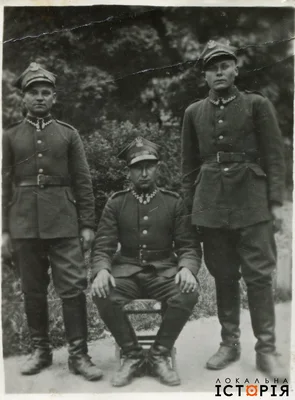
Soldiers of the Polish army. On the far right, Mykhailo Mamchur from the village of Hrymaylivka (now Ternopil oblast), 1930s. Photo: personal archive of Maria Mykhalchuk
Krivosheev’s group in the study called “Russia and the USSR in the wars of the twentieth century: losses of armed forces. Statistical research” tried to calculate the Soviet losses of the interwar period. However, it was never able to go beyond the Soviet paradigm. Losses for 1939–1941 are considered separately. Embedded in the strict restrictions of the myth about the “Great Patriotic War,” the Second World War for Russians is limited to the years 1941–1945. The Kremlin does not want to remember the first period of the war, in which the USSR was not a victim but an aggressor. And using an ethnic basis for counting losses made it possible for Russian military experts to reduce the statistics representing people from national republics to 33.6%.
Above all, measuring each Soviet republic’s contribution to the war by the number of dead soldiers is completely macabre Soviet logic. However, it’s easy to see why this made sense to Putin, a former KGB officer, and the group of historians who serve the Kremlin’s ideological needs.
How many Ukrainians actually died?
According to the calculations of the Mykhailo Ptoukha Institute for Demography and Social Studies of the National Academy of Sciences of Ukraine, the population of the Ukrainian SSR during the Great Patriotic War decreased by 10.4 million people, from 42.4 million as of June 22, 1941, to 32 million as of May 8, 1945.
According to Ukrainian historians, about 7 million Ukrainian citizens fought in the Red Army. This accounted for approximately 23% of the total number of the Armed Forces of the USSR.
There were 5.2 million civilian deaths: 3 million people were killed and 2.2 million died because of the difficulties of war.
There were 3.3 million military personnel killed, including 2.8 million soldiers and 0.5 million partisans and militiamen.
How did the Ukrainians contribute to the victory?
By the end of the summer of 1941, 3.2 million soldiers had been mobilized from the territory of Ukraine to join the Red Army. Ukrainians made up 50% of the troops of the so-called South-Western Front. In 1943–1945, another 4.5 million people were recruited. Starting in the second half of 1943, Ukrainians accounted for 60–80% of soldiers in parts of the Ukrainian Front.
The Ukrainians also helped in the rear. About 3.5 million citizens of the Republic, 550 industrial enterprises, 70 universities, 40 theatres, and dozens of museums were moved from Ukraine deep into the peaceful territories. All hands worked in the deep behind to achieve victory.
The human “resource” that Putin spoke about has a qualitative dimension.
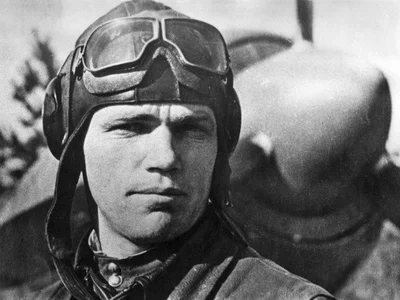
Three times Hero of the Soviet Union, Ukrainian ace pilot Ivan Kozhedub. Photo: Wikipedia
For their contribution to the German-Soviet war, 2.5 million Ukrainians were given orders and medals. The title “Hero of the USSR” was given to 2,000 soldiers who showed particular courage. Three times the hero was the pilot ace Ivan Kozhedub; twice the heroes were 32 soldiers, including Oleksandr Molodchyi, Dmytro Hlinka, Pavlo Taran, Mykhailo Bondarenko, Oleksii Mazurenko, Anatolii Nedbailo, Vasyl Mykhlyk, Fedir Kompaniets, and others.
For example, in the award letter of Senior Sergeant Kompaniets, a participant in the largest in the history of the Arctic Petsamo–Kirkenes offensive, was written: “The squad commander, Senior Sergeant Kompaniets, at the head of the department, was the first to cross at night, despite the strongest artillery mortar machine gun fire of the enemy water line—the Bay of Bøkfjorden, successfully maneuvering, using the supports of the blown-up bridge. He jumped over to the enemy’s side of the water and fired to protect the battalion’s crossing. Destroying small groups of the enemy with fire, he quickly advanced and was the first to enter Kirkenes with his squad.”
Among the top leadership of the Red Army were many Ukrainians: Hryhorii Kulyk, Semen Tymoshenko, Ivan Cherniakhivskyi, Andrii Hrechko, Andrii Yeriomenko, Kyrylo Moskalenko, Pylyp Zhmachenko, Rodion Malynovskyi. These generals led successful offensive operations on the fronts.
From the beginning of the Nazi invasion, Ukraine was the scene of bloody fighting. It was on Ukrainian territory that the first major battles of the Eastern Front took place: the Volyn tank battle and operations for the defense of Kyiv, Odesa, and Sevastopol. The Ukrainian territory took on the drama of two large encirclements: Kyiv (the largest in history) and Uman.
The decisive battles of the Soviet-German war are connected with Ukraine. 60% of the Nazi ground forces were defeated here. In 1943–1944, 12 offensive and 2 defensive operations took place on Ukrainian territory.
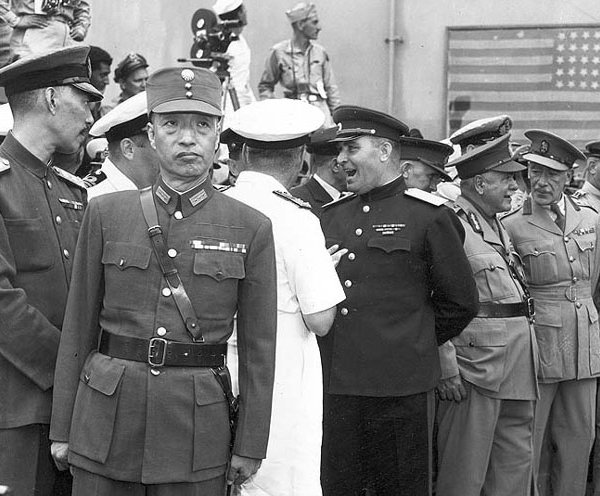
Kuzma Derevianko before signing the Japanese surrender, 2 September 1945. Photo: Historical Truth
The group of flag bearers who raised the “Victory Banner” over the Reichstag was headed by Ukrainian lieutenant Oleksii Berest. One of the commanders who accepted Japan’s surrender on behalf of the USSR was General Kuzma Derevianko.
It is obvious that the Russian Soviet Federative Socialist Republic could not have defeated Nazism without the human, industrial, and territorial resources of Ukraine. But should Ukraine “measure” the statistics of losses in the German-Soviet war?
Should Ukraine discuss winning the way Russia does?
Ukrainians fought in World War II not just in the Red Army, but also in Soviet partisan detachments, in the ranks of the Ukrainian Insurgent Army, and in the detachments of the French, Yugoslavian, and Slovak resistance movements. About 50 thousand Ukrainians were soldiers in the Canadian, American, Australian, and British armies.
Ukraine paid a high price for Stalin’s adventure. The Soviet Generalissimo, along with Hitler, are responsible for this war. The Soviet Union got away with everything; the principle of “winners are not judged” worked out. Moscow has evaded not only political but also historical responsibility. The Tomb of the “Unknown Soldier” in Russia has become a symbol of oblivion. Russian historical politics now uses the “dead souls” of Soviet soldiers as a “symbolic” resource.
The world must understand that the Soviet army is not equal to the concept of the Russian army. Ukraine needs to honor all its heroes by name, in particular those like Fedir Kompaniets, who not only won but also survived. And Russia should have realized that human resources are measured by life, not death.

